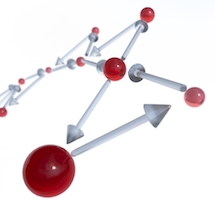Rock-paper-scissors pushed to the edge
Johannes Knebel*, Philipp M. Geiger*, Erwin Frey
 Topology describes properties of systems that are preserved under continuous deformations and only change stepwise. We have shown that topology explains a certain transition in evolving populations, opening the door for applications of topological phases in biological systems.
Topology describes properties of systems that are preserved under continuous deformations and only change stepwise. We have shown that topology explains a certain transition in evolving populations, opening the door for applications of topological phases in biological systems.
Topology is a long-standing theme in physics and was first used to characterize phases of condensed matter in the context of the Quantum Hall effect in the 1980s. Topological arguments explain why these phases are located at the system’s edge and why they are robust against perturbations of internal interactions and external noise.
In our study, we reveal that such topological arguments also explain the dynamics of a biological model system, which dates back to Volterra’s seminal work on population dynamics from the 1930s. The building blocks of the model are so-called rock-paper-scissors cycles that represent a classical theme in game theory: rock smashes scissors, scissors cuts paper, and paper wraps rock in a cyclically competing manner.
In our model, we coupled the rock-paper-scissors cycles along a one-dimensional chain. We observed that species either at the left or at the right edge of the chain dominate the whole system, very much reminiscent of the polarisation of a rod, on which electrical charges are pushed either to the rod’s left or right end. Whether the evolutionary dynamics is polarized to the left or right edge depends on a single ratio of the interaction parameters and is robust against small perturbations of the interactions.
By borrowing concepts from topology as developed in condensed matter physics, we were able to explain the polarisation of the evolutionary dynamics as topological phases, which are also realised by topological superconductors in one dimension.
The present work is a first step towards the application of topological phases in biological systems. It might be even possible to design topological phases in gene regulatory networks. How such topological phases may be realized in a biological experiment poses an interesting question for future research.

